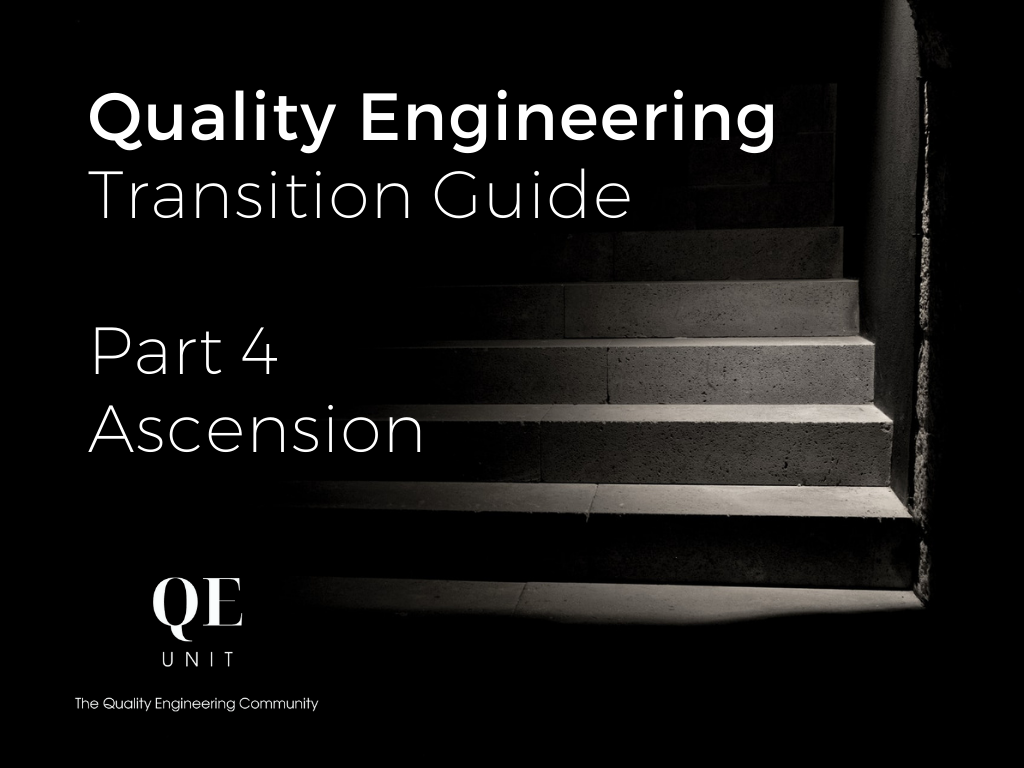Only continuous training maintains high performance.
The previous transitions have allowed you to drive, reveal and extend Quality Engineering in your organization. The challenge now is to maintain this high level of performance in continuous improvement.
The balance between global and local actions will make it possible to develop the system as a coherent whole, while keeping a latitude for action depending on the context. Adaptation is again key.
Quality Engineering is the paradigm for constraining software chain activities to continuous value delivery. Achieving it requires acting on the pillars of MAMOS: Methods, Architecture, Management, Organization, Skills.
This article shares important practices for maintaining Quality Engineering in your organization. The elements mentioned can and must be completed proactively by the different teams.
This first transition guide offers an incremental approach to develop Quality Engineering in your organization. Each of the transitions contains the actions from the framework to optimize your transition effort.
Follow the QE Unit for more exclusive content of Quality Engineering.
Anchor and guide the continuous improvement of practices
At this stage, most of the organization will have adopted your Quality Engineering practices. The challenge is to succeed in creating an ecosystem capable of learning and improving its performance with maximum autonomy.
The actors at the center of the system are the pivotal elements on which to rely. By developing their skills, they can themselves become ambassadors of practices and continuous improvement.
“If you want to grow an organization then enable its employees to experiment, explore and express their creativity without limiting them to title, department & designation.”
Aiyaz Uddin
The remaining task for the initial leaders of the Quality Engineering process is to be the last bulwark of culture. The aim is to reach a level of maturity in which they would theoretically become unnecessary.
To do this, they must rely on the organizational culture and the management of value creation. Mechanisms at scale must be in place to ensure the continued value delivery of the system.
Develop organizational capabilities to scale
The development of organizational capabilities requires a minimum of skills at the right level to train the actors of a team to the same standard. Replicating this mechanism at scale will create a capability.
Raising the level first requires identifying the gaps in the organization, for example via a skills matrix and an exercise of gap analysis. This inventory allows you to define an action plan according to your possibilities.
It is ideally necessary to quickly fill the skills on the teams with higher added value. You can do this by changing team members or using external resources. Investing in continuing education will help you on an ongoing basis.
Scaling-up specific skills will support performance and continuous improvement. The methods of Lean Problem Solving and Lean Continuous Improvement will force small steps, also thanks to the influence.
- Develop the missing skills
- Lean Problem Solving
- Lean Continuous Improvement
- Influence
Guiding teams to complement and adapt their practices
The expansion of your dynamic must go through relays to maintain a dissemination of practices throughout the organization. This requires knowing how to guide the actors in a relatively autonomous and self-learning system.
You can systematize the definition of business metrics for each of your Quality Engineering units. The use of OKR is often recommended in scaling like in Safe or at GitLab.
Continuous improvement also requires continuous curiosity. We must therefore encourage stakeholders to open up to the outside to discover new practices, discuss and question their mechanisms. You must give them the means.
Teams need visibility into the ecosystem to keep the big picture and drive the most relevant improvements. The setting up of an Observability Pipeline will be useful, concretized for example through engineering productivity.
- Business driven
- Observability Pipeline
- Experimentation
- Curiosity
- Dogfooding
- Developer on Test
Maintain the organizational culture of Quality Engineering
Your investments have enabled you to develop a real culture of Quality Engineering in our organization. Maintaining this culture requires continuous attention in an ever-changing ecosystem.
Teams, regardless of their model, will tend to local optimization. The management will have to continuously reiterate the cross-functional value, the focus on the customer, and the priorities to be delivered beyond organizational silos.
Leaders must therefore be in the field, in contact with teams, sharing their convictions, pushing players to improve and find solutions to the challenges they encounter. Their feedback skills will be essential for this.
Continuous improvement involves continuous measurement and adaptation. Moreover, it is this acceleration of value delivery that a Quality Engineering ecosystem at the high standard will allow you to achieve.
- Organizational culture
- Maintain culture
- Guarantee processes
Initiating your transition to Quality Engineering
The implementation of Quality Engineering results from the proper conduct of the various identified transitions. Efforts must be channeled at each stage without wanting to skip it, at the risk of creating organizational fatigue.
This final ascension transition is actually a succession of iterations to continuously adapt the ecosystem. The challenge is to maintain a continuous delivery of value by containing entropy, stripped of all waste.
Quality Engineering leaders must combine their expertise in change management and software to be successful. The high standard pushes to increase the level of demand continuously, a real challenge when time is of the essence.
Act now on your transitions to drive your organization to continuous value delivery. The path requires effort, but which will be visible by an incremental approach, carrying energy throughout the transitions.
Follow the QE Unit for more Quality Engineering.
